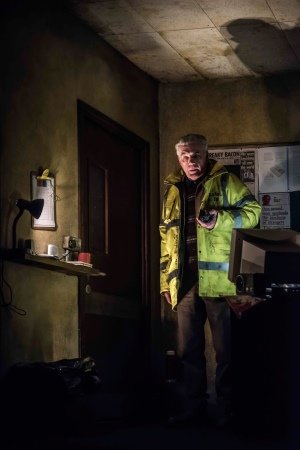Written by Jeremy Dyson and Andy Nyman, Ghost Stories has captivated and creeped out audiences worldwide since it opened to roaring success in 2010, even making its way to the big screen in an adaptation starring Nyman alongside stalwarts like Paul Whitehouse and Martin Freeman. It’s also perhaps the first major horror production since Paranormal Activity to market itself primarily through audience reactions. Having experienced several so-called horror shows in the theatre that either spooked me or didn’t even raise a hair on the back of my neck, Ghost Stories delivered on its promised frights and then some. Forget sleeping with the light on – I may never sleep again.
We’re urged, first by the programme and then by creepy voiceover as we take our seats, to preserve the twists of the show in a bid for secrecy the likes of which I hadn’t seen since Harry Potter and the Cursed Child compelled its audiences to #KeepTheSecrets – but to be honest, I don’t think I could spoil this show even if wanted to, because I saw most of it through my fingers. It is simply the most frightening ninety minutes I have ever experienced; I barely breathed for most of it, because the show conjured a sense of dread so unrelenting and oppressive I’m still reeling from the shock of it now.

It might seem like a negative reaction to any other show – but this is the kind of production for which such a response must be music to the creative team’s ears. The marketing warned those of a nervous disposition to stay away but, as our master of ceremonies Professor Goodman (Joshua Higgott) observes, there’s a reason we came here to be scared, and the show confronts you with your own fears as much as it conjures up new ones to haunt your dreams. And once you’re in, you’re locked in – latecomers are not admitted, there’s no interval, and if it gets too much for you, you have to either stick it out or leave the story for good, because if you go there’s no coming back. You feel as if you’re trapped in a living nightmare with no way out.

There is real ingenuity on display here, the kind that Alfred Hitchcock used to draw frights out of chocolate syrup. The performances never stray into melodrama or pastiche; instead the superb ensemble – Higgott, Paul Hawkyard, Gus Gordon, Richard Sutton and Lloyd McDonagh – anchor the escalating strangeness and bring a lightness of touch that blends comedy and horror without damaging the integrity of either. (Though, make no mistake, this isn’t Shaun of the Dead – the laughs are mainly there give you a brief reprieve from the torturous tension). But the real unsung heroes of the show are the team responsible for the production design, lighting and sound – while the story and characters compel, it’s the creative team’s peerless work that will haunt you long after the shocking denouement.

This is perhaps the first show I couldn’t find fault with that I also could never bring myself to see again. I can never unsee many of the horrifying images that kept me locked in my seat even when my fight-or-flight instinct was telling me to leap over the back and make a break for the exit. At one point, Professor Goodman laments how the oral tradition of storytelling has been supplanted by the hyperbolic immediacy of our Twitter-centric age. What Ghost Stories does it to rekindle the smouldering ember of this ancient tradition, gathering its rapt audience around the fire of its singular vision in a way that only theatre can truly capture. The secrets of this show are worth unravelling – but are you brave enough to find out for yourself?
